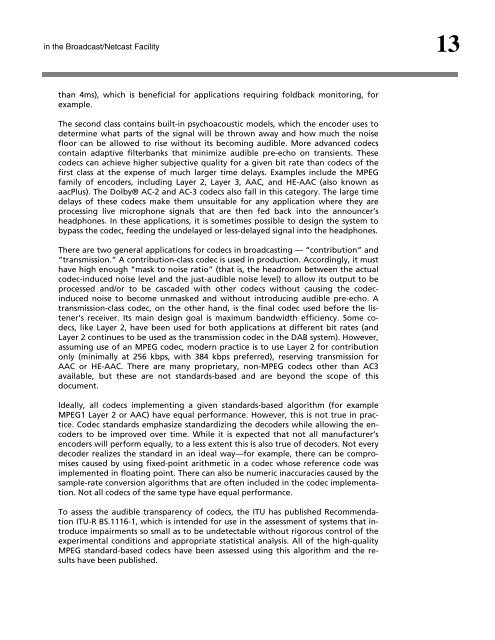Maintaining Audio Quality in the Broadcast Facility 2011 - Orban
Maintaining Audio Quality in the Broadcast Facility 2011 - Orban
Maintaining Audio Quality in the Broadcast Facility 2011 - Orban
Create successful ePaper yourself
Turn your PDF publications into a flip-book with our unique Google optimized e-Paper software.
<strong>in</strong> <strong>the</strong> <strong>Broadcast</strong>/Netcast <strong>Facility</strong> 13<br />
than 4ms), which is beneficial for applications requir<strong>in</strong>g foldback monitor<strong>in</strong>g, for<br />
example.<br />
The second class conta<strong>in</strong>s built-<strong>in</strong> psychoacoustic models, which <strong>the</strong> encoder uses to<br />
determ<strong>in</strong>e what parts of <strong>the</strong> signal will be thrown away and how much <strong>the</strong> noise<br />
floor can be allowed to rise without its becom<strong>in</strong>g audible. More advanced codecs<br />
conta<strong>in</strong> adaptive filterbanks that m<strong>in</strong>imize audible pre-echo on transients. These<br />
codecs can achieve higher subjective quality for a given bit rate than codecs of <strong>the</strong><br />
first class at <strong>the</strong> expense of much larger time delays. Examples <strong>in</strong>clude <strong>the</strong> MPEG<br />
family of encoders, <strong>in</strong>clud<strong>in</strong>g Layer 2, Layer 3, AAC, and HE-AAC (also known as<br />
aacPlus). The Dolby® AC-2 and AC-3 codecs also fall <strong>in</strong> this category. The large time<br />
delays of <strong>the</strong>se codecs make <strong>the</strong>m unsuitable for any application where <strong>the</strong>y are<br />
process<strong>in</strong>g live microphone signals that are <strong>the</strong>n fed back <strong>in</strong>to <strong>the</strong> announcer’s<br />
headphones. In <strong>the</strong>se applications, it is sometimes possible to design <strong>the</strong> system to<br />
bypass <strong>the</strong> codec, feed<strong>in</strong>g <strong>the</strong> undelayed or less-delayed signal <strong>in</strong>to <strong>the</strong> headphones.<br />
There are two general applications for codecs <strong>in</strong> broadcast<strong>in</strong>g — “contribution” and<br />
“transmission.” A contribution-class codec is used <strong>in</strong> production. Accord<strong>in</strong>gly, it must<br />
have high enough “mask to noise ratio” (that is, <strong>the</strong> headroom between <strong>the</strong> actual<br />
codec-<strong>in</strong>duced noise level and <strong>the</strong> just-audible noise level) to allow its output to be<br />
processed and/or to be cascaded with o<strong>the</strong>r codecs without caus<strong>in</strong>g <strong>the</strong> codec<strong>in</strong>duced<br />
noise to become unmasked and without <strong>in</strong>troduc<strong>in</strong>g audible pre-echo. A<br />
transmission-class codec, on <strong>the</strong> o<strong>the</strong>r hand, is <strong>the</strong> f<strong>in</strong>al codec used before <strong>the</strong> listener’s<br />
receiver. Its ma<strong>in</strong> design goal is maximum bandwidth efficiency. Some codecs,<br />
like Layer 2, have been used for both applications at different bit rates (and<br />
Layer 2 cont<strong>in</strong>ues to be used as <strong>the</strong> transmission codec <strong>in</strong> <strong>the</strong> DAB system). However,<br />
assum<strong>in</strong>g use of an MPEG codec, modern practice is to use Layer 2 for contribution<br />
only (m<strong>in</strong>imally at 256 kbps, with 384 kbps preferred), reserv<strong>in</strong>g transmission for<br />
AAC or HE-AAC. There are many proprietary, non-MPEG codecs o<strong>the</strong>r than AC3<br />
available, but <strong>the</strong>se are not standards-based and are beyond <strong>the</strong> scope of this<br />
document.<br />
Ideally, all codecs implement<strong>in</strong>g a given standards-based algorithm (for example<br />
MPEG1 Layer 2 or AAC) have equal performance. However, this is not true <strong>in</strong> practice.<br />
Codec standards emphasize standardiz<strong>in</strong>g <strong>the</strong> decoders while allow<strong>in</strong>g <strong>the</strong> encoders<br />
to be improved over time. While it is expected that not all manufacturer’s<br />
encoders will perform equally, to a less extent this is also true of decoders. Not every<br />
decoder realizes <strong>the</strong> standard <strong>in</strong> an ideal way—for example, <strong>the</strong>re can be compromises<br />
caused by us<strong>in</strong>g fixed-po<strong>in</strong>t arithmetic <strong>in</strong> a codec whose reference code was<br />
implemented <strong>in</strong> float<strong>in</strong>g po<strong>in</strong>t. There can also be numeric <strong>in</strong>accuracies caused by <strong>the</strong><br />
sample-rate conversion algorithms that are often <strong>in</strong>cluded <strong>in</strong> <strong>the</strong> codec implementation.<br />
Not all codecs of <strong>the</strong> same type have equal performance.<br />
To assess <strong>the</strong> audible transparency of codecs, <strong>the</strong> ITU has published Recommendation<br />
ITU-R BS.1116-1, which is <strong>in</strong>tended for use <strong>in</strong> <strong>the</strong> assessment of systems that <strong>in</strong>troduce<br />
impairments so small as to be undetectable without rigorous control of <strong>the</strong><br />
experimental conditions and appropriate statistical analysis. All of <strong>the</strong> high-quality<br />
MPEG standard-based codecs have been assessed us<strong>in</strong>g this algorithm and <strong>the</strong> results<br />
have been published.



![[PDF] Using the ITU BS.1770-2 and CBS Loudness Meters ... - Orban](https://img.yumpu.com/50629372/1/190x245/pdf-using-the-itu-bs1770-2-and-cbs-loudness-meters-orban.jpg?quality=85)






![[PDF] Optimod-FM Feature Comparison - Orban](https://img.yumpu.com/41741615/1/190x245/pdf-optimod-fm-feature-comparison-orban.jpg?quality=85)






